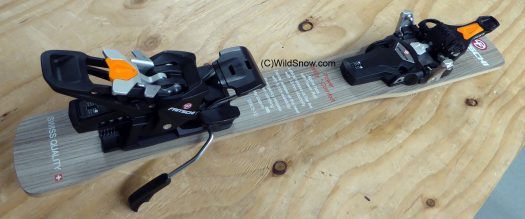Fritschi Tecton FAQ

Fritschi Tecton ski touring binding, to begin retail during fall of 2017.
We whipped up a Tecton mounting template for you DIYers out there in radio land.
Related Links:
Tecton mounted and tested.
Hanging out with Fritschi at ISPO 2017.
Removing and installing Tecton brakes.
Search for Tecton blog posts on WildSnow.
Frequently Asked Questions FAQ
How much does Tecton weigh, and other specifications?
Out of the box weight: with 100 mm brake and screws, 678 grams. What’s that mean? Compare to another major brand “freeride” tech binding with brake but without the alpine-like heel, at 642 grams. Only 36 grams (1.3 ounces) for that impressive Tecton heel unit.
Is there a paper mounting template available?
We published our Fritschi Tecton template jig here.
I’m mounting my own bindings, how do I assemble the brake?
See our article covering Tecton ski brake install.
Does Tecton work with any ski touring boot; or their boot incompatibilities?
Most certainly, some boots may not function correctly with this binding. Main concerns:
1. The boot must have a toebox shape that will eject the boot from the binding when a forward release completes. This is produced by the boot toe hitting the binding toe lock lever. Easy to test on the workbench — but do so BEFORE you go to the trouble and expense of mounting your own bindings on your own skis! Nearly all boots are fine, but testing each combination is important.
2. The boot heel must have a “DIN” standard shape, providing adequate shelf area for the binding cup. Most ski touring boots provide this, exceptions possibly being boots such as Atomic Backland, Dynafit TLT 5/6, and many race oriented boots.
3. You need a rigid boot, nearly all are, exceptions being telemark boots and the Dynafit TLT5. A boot with metatarsal flex will “sag” and could cause the heel unit to have inadequate retention of the boot heel, in turn causing accidental release.
What are the touring heel lift heights?
Heel lift in touring mode depends on how high your boot toe is stacked above ski, in terms of how much climbing angle you really get. The best way to evaluate is comparison to a binding you have on hand, using the following numbers:
Tecton height of boot toe above ski, measured to CENTER OF TOE PINS is 40.5 mm
Heel height flat, measured to bottom of boot sole: ~28 mm (difference 12.5)
Heel height medium, measured to bottom of boot sole: ~66 mm (difference 25.5)
Heel height high, measured to bottom of boot sole: ~92 mm (difference 51.5)
For clarity on heel lift height, imagine another tech binding you are comparing. Perhaps the comparison binding has a toe pin height of 30 mm and high heel lift of 83 mm, both measured from the ski top. That means your comparison rig could be said to have a “high heel lift difference” of 50 mm, while the Tecton has a difference of 51.5, meaning both bindings are virtually the same in terms of maximum heel lift in the high mode. By the same token, a boot/binding combo that achieves a neutral heel lift (“heel flat on ski”) in our comparison would have something like a toe pin height of 30 mm and a 20 mm distance between boot sole and ski top. This difference with Tecton is 12.5, meaning in real-life use Tecton has a noticeably low and flat angle when run at the lowest heel lift.
Is Tecton “safer?”
Clearly, the Tecton ski touring binding functions quite differently than most other “tech” bindings, in that the side release occurs at the toe, and the heel has “alpine like” step-in as well as extended vertical elastic travel. Do those features make Tecton safer? Sure, if you qualify the word “safer” to apply to how well the binding holds you on the ski while skiing (“retention”) — at certain exact angles and forces, as well as applying to highly specific injury scenarios. Thus, calling out a particular ski binding as “safer” has no real meaning in a scientific or engineering sense. Adding to the confusion, the different mechanicals of other tech bindings could sometimes be said to be “safer.” For example, a binding that releases to the side at the heel might do a better job of protecting your knees from soft tissue injuries. We do not have the authority, qualifications or testing equipment to unequivocally state that one binding is generally “safer” than another. In fact, no one can do this as the word “safer” has to always apply to specific modes of accident or injury. For example, one could say that a modern alpine skiing binding is “safer” in terms of protecting your legs from tibial fractures, as opposed to early “bear trap” bindings with no lateral release. In that vein, the astute individual can certainly draw logical conclusions. For example, if you ski aggressively, having more vertical elastic travel could allow you to use a reasonable tension setting for vertical release, while avoiding accidental release — thus increasing “safety” in terms of retention. Get educated, and draw your own conclusions.

